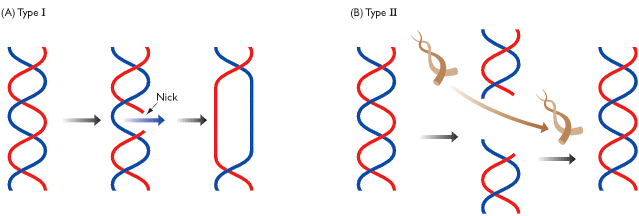
This image is just a residue of topoisomerase II (PDB 1BJT). This is the core that binds to and cleaves the DNA (residues 409-1201). The spaces where DNA fits are apparent in this structure. Because this is only a residue, this is all one chain.

In this image (PDB 2RGR) we can see the same topoisomerase II residue as before, but now it is bound to the helical DNA (shown in pink and blue). Topoisomerase II helps relax super-coiling and repairs knots in the DNA by cutting through both strands and releasing tension.
Topoisomerases are enzymes that help regulate the over-winding or under-winding of DNA. The winding can also lead to tangles or knots in the DNA that can inhibit and affect transcription processes and DNA replication. Because of their function in aiding in these problems, topoisomerases are vital enzymes in the body with unique and interesting chemistry.
In the most simplest form, topoisomerases bind to the DNA to cut the phosphate backbone. Once the DNA is cut, it allows for the tension to be relieved or the knot to be released. After this occurs, the DNA backbone is resealed the the DNA is fixed.

(http://www.lookfordiagnosis.com/mesh_info.php?term=dna+topoisomerases%2C+type+i&lang=1)
There are two different types of topoisomerases that function in the body. Type I (as you can see in the above diagram) just cuts through one strand of the DNA. This "nick" functions best at just relieving tension, but wouldn't help with knots that occur. This is where the type II topoisomerase comes in handy. Type II cuts through both strands of the DNA, allows for an unbroken piece of DNA to go through the break, and then finally reseals the strands. This fixes knots that would be expected to occur with the condensation of DNA.
Class II topoisomerases require ATP to fix knots. When it binds to one part of the DNA (G-segment), it uses ATP to bind to another parts (T-segment). The topoisomerase cuts the G-segments to allow the T-segment to pass through the break and fix the problem of the knot. Then the G-segment is glued back together and the topoisomerase releases. You can see this occur in the figure below.
(http://www.udel.edu/chem/bahnson/chem645/websites/Sapra/Mechanism%20of%20type%20II%20topoisomerase.html)
Because of its uses, topoisomerase inhibitors are increasingly being used as anti-cancer drugs. When these drugs interfere with enzyme activity, the topoisomerase may not be able to fix knots, or it will break the DNA, but not reseal the ends. Both of these could be detrimental to the cells. Replication would be inhibited which is a feature of cancer cells. While no other disease is currently treated using topoisomerase II, future research could lead to new possibilities.
As you can expect, topoisomerase II are very important in your body for normal replication and transcription. These enzymes are fascinating in their way of releasing knots by introducing double-stranded breaks. Cell survival is impacted by the function of these enzymes and they deserve to be protein of the year.

(http://en.wikipedia.org/wiki/Type_II_topoisomerase)
Sources:
Champoux JJ (2001). "DNA topoisomerases: structure, function, and mechanism". Annu. Rev. Biochem. 70: 369–413.
http://www.ebi.ac.uk/interpro/potm/2006_1/Page2.htm
Willmore E, de Caux S, Sunter NJ et al. (2004). "A novel DNA-dependent protein kinase inhibitor, NU7026, potentiates the cytotoxicity of topoisomerase II poisons used in the treatment of leukemia". Blood 103 (12): 4659–65.
No comments:
Post a Comment